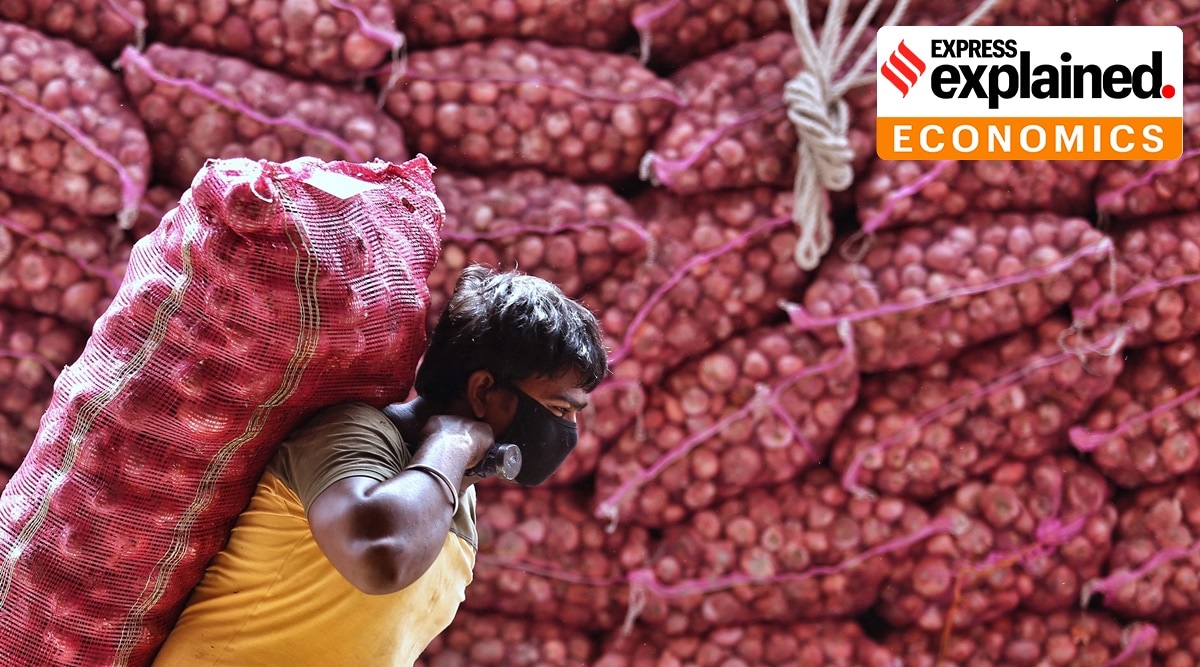
[ad_1]
 A worker carries a sack of onions at the APMC market in Ahmedabad on September 7, 2020. (Express Photo: Nirmal Harindran)
A worker carries a sack of onions at the APMC market in Ahmedabad on September 7, 2020. (Express Photo: Nirmal Harindran)
On Monday, a shaken central government issued a notification prohibiting the export of onions even as the average traded price of the bulb crossed the psychological barrier of Rs 30 per kg at Maharashtra’s Lasalgaon wholesale market. This ban came just about three months after the Narendra Modi-led government tweaked the archaic Essential Commodities Act, 1955 to make the imposition of stock limit and movement restrictions on food grains, edible oilseeds, potatoes, onions and other essential commodities only applicable in extreme conditions like war or natural calamity. The export ban comes even as the central government works on making the ordinance a law.
A look at the export ban, and its possible repercussion in the days to come.
What were the triggers that led to the export ban?
There seem to be two main triggers that prompted the government to take the extreme step of putting a blanket ban on exports of all kinds of onions. The first was obviously the steady increase in wholesale prices of onions which has seen the kitchen staple becoming costlier in the urban markets. Between March and September, the average price of the bulb at Lasalgaon’s market has appreciated by almost 100 per cent. Prices at the markets in Niphad taluka of Nashik district, which were in the range of Rs 1,500 per quintal in March, have since appreciated to Rs 3,000. At retail markets, onion is now trading between Rs 35-40 per kg as against the Rs 25-30 per kg in June.
The immediate trigger which led to the ban can also be found in the Consumer Price Index (CPI) numbers released by the Ministry of Statistics and Program Implementation (MoSPI) on Monday. The numbers, which measures the inflation was 6.69 per cent a tad bit lesser than the 6.73 of last month but well above the Reserve Bank of India (RBI)’s target of 6 per cent. The Consumer Food Price Index (CFPI) for August was 9.05 as against 9.27 of last month.
At the policy level, the high CFPI and the rising price of onion were enough triggers to get an export ban on onion at a time when farmers were offloading their stored onions.
Also in Explained | Eggs or not: Why Madhya Pradesh is debating anganwadi meals again
Why are onions costlier in wholesale markets?
The answer to this question can be found in the exceptionally heavy rains which lashed the country in August. Those rains have led to a near-complete washout of the almost market-ready onion crop in Karnataka which was to hit the markets early in September. Along with this, the rains have also wreaked havoc on the stored onions in Madhya Pradesh, Gujarat and parts of Maharashtra. At present, it is only the onion growers in Maharashtra who have stored up the produce which they harvested in March-April. The supply disruption is likely to continue till the new crop in Maharashtra hits the markets early November.
If the domestic supply-demand situation was heavily tilted towards the latter, demand for Indian onion was also rising from international markets. Indian onions, normally shipped out countries in the Gulf, Sri Lanka and Bangladesh, have a year-round steady demand. However, demand from Sri Lanka, exporters say has suddenly picked up as the island nation also has reported heavy destruction of their crop due to rains. The landed cost of Indian onions at Dubai port at this moment is around Rs 32-35 per kg which has led many exporters to increase their shipments from Nashik.
📣 Express Explained is now on Telegram. Click here to join our channel (@ieexplained) and stay updated with the latest
So will the export ban bring down onion prices?
Once the markets open for trade on Tuesday, a sharp depreciation in prices is expected to take place in view of the export ban. However, traders feel the prices are again going to rise in a week or so as the overall supplies will remain stressed. The new crop, they say, will arrive only post November and with the demand expected to rise before the Dussehra festive season starts, prices will continue to remain bullish.
Will the onion export ban have any political fallout?
The political fall out of high onion prices can hardly be overemphasized. With Bihar election likely to be held later this year, the government it seems was wary of going to the electorate when the kitchen staple was costlier than usual.
Ironically the export ban comes when the government plans to make the ordinances that amended the Essential Commodities Act into law and stop knee-jerk reactions like the imposition of stock limits. Farmers’ organisations were quick to call out the “double standard” on part of the government. From Tuesday, Shetkari Sanghtana, the farmer’s union started by legendary farmer’s leader Sharad Joshi, has started protests against this move.
📣 The Indian Express is now on Telegram. Click here to join our channel (@indianexpress) and stay updated with the latest headlines
For all the latest Explained News, download Indian Express App.
© The Indian Express (P) Ltd
[ad_2]
Source link